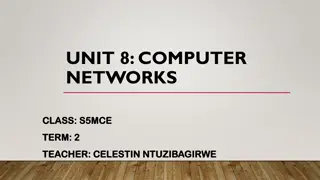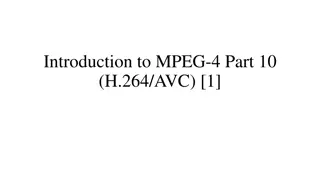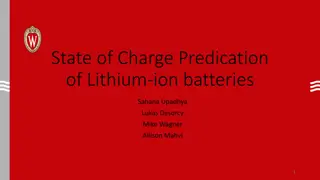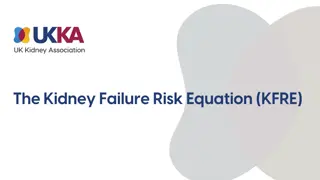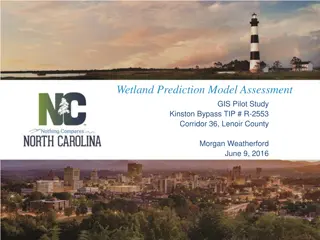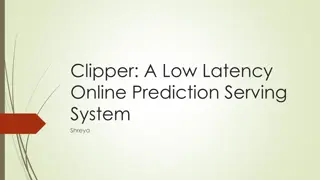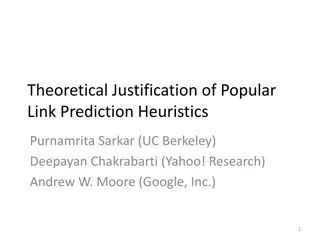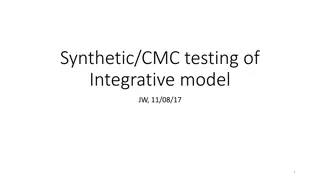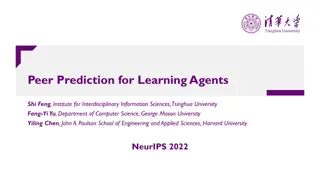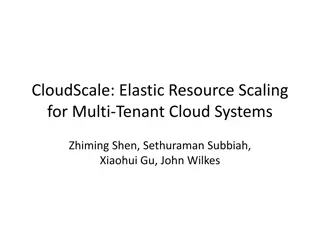Link Prediction in Social Networks
This presentation discusses the importance of link prediction in social networks, including applications like recommending new friends, predicting actor participation in events, suggesting interactions between organizations, and overcoming data sparsity in recommender systems. It covers motivations, outlining methods for estimating edge scores, problem definition, and detailed problem formulation for predicting future network connections.
Uploaded on Oct 10, 2024 | 0 Views
Download Presentation

Please find below an Image/Link to download the presentation.
The content on the website is provided AS IS for your information and personal use only. It may not be sold, licensed, or shared on other websites without obtaining consent from the author.If you encounter any issues during the download, it is possible that the publisher has removed the file from their server.
You are allowed to download the files provided on this website for personal or commercial use, subject to the condition that they are used lawfully. All files are the property of their respective owners.
The content on the website is provided AS IS for your information and personal use only. It may not be sold, licensed, or shared on other websites without obtaining consent from the author.
E N D
Presentation Transcript
14 Link Prediction 1
Motivation Recommending new friends in online social networks. Predicting the participation of actors in events Suggesting interactions company/organization that are external to the hierarchical structure of the organization itself. Predicting connections between organizations who have not been directly observed to work together. Suggesting collaborations between researchers based on co- authorship. Overcoming the data-sparsity problem in recommender systems using collaborative filtering between the members of a members of terrorist 2
Motivation In social networks: Increases user engagement Controls the growth of the network 3
Outline Estimating a score for each edge (seminal work of Liben-Nowell&Kleinberg) Classification approach The who to follow service at Twitter 4
Problem Definition Link prediction problem: Given the links in a social network at time t, predict the edges that will be added to the network during the time interval from time t to a given future time t Based solely on the topology of the network (social proximity) (the more general problem also considers attributes of the nodes and links) Different from the problem of inferring missing (hidden) links (there is a temporal aspect) To save experimental effort in the laboratory or in the field 5
Problem Formulation (details) Consider a social network G = (V, E) where each edge e = <u, v> E represents an interaction between u and v that took place at a particular time t(e) (multiple interactions between two nodes as parallel edges with different timestamps) For two times, t < t , let G[t, t ] denote subgraph of G consisting of all edges with a timestamp between t and t For four times, t0< t 0< t1< t 1, given G[t0, t 0], we wish to output a list of edges not in G[t0, t 0] that are predicted to appear in G[t1, t 1] [t0, t 0] training interval [t1, t 1] test interval 6
Problem Formulation (details) Prediction for a subset of nodes Two parameters: trainingand test Core: all nodes that are incident to at least trainingedges in G[t0, t 0], and at least testedges in G[t1, t 1] Predict new edges between the nodes in Core 7
Example Dataset: co-authorship t0= 1994, t 0= 1996: training interval -> [1994, 1996] t1= 1997, t 1= 1999: test interval -> [1997, 1999] - Gcollab= <V, Eold> = G[1994, 1996] - Enew: authors in V that co-author a paper during the test interval but not during the training interval training= 3, test= 3: Core consists of all authors who have written at least 3 papers during the training period and at least 3 papers during the test period Predict Enew 8
Methods for Link Prediction (outline) Assign a connection weight score(x, y) to each pair of nodes <x, y> based on the input graph Produce a ranked list of decreasing order of score We can consider all links incident to a specific node x, and recommend to x the top ones If we focus to a specific x, the score can be seen as a centrality measure for x 9
Methods for Link Prediction (outline) How to assign the score(x, y) between two nodes x and y? Some form of similarity or node proximity 10
Methods for Link Prediction: Neighborhood-based The larger the overlap of the neighbors of two nodes, the more likely the nodes to be linked in the future 11
Methods for Link Prediction: Neighborhood-based Let (x) denote the set of neighbors of x in Gold Common neighbors: A adjacency matrix Ax,y2:Number of different paths of length 2 Jaccard coefficient: The probability that both x and y have a feature for a randomly selected feature that either x or y has 12
Methods for Link Prediction: Neighborhood-based Adamic/Adar Assigns large weights to common neighbors z of x and y which themselves have few neighbors (weight rare features more heavily) Neighbors who are linked with 2 nodes are assigned weight = 1/log(2) = 1.4 Neighbors who are linked with 5 nodes are assigned weight = 1/log(5) = 0.62 13
Methods for Link Prediction: Neighborhood-based Preferential attachment Based on the premise that the probability that a new edge has node x as its endpoint is proportional to | (x)|, i.e., nodes like to form ties with popular nodes Researchers found empirical evidence to suggest that co-authorship is correlated with the product of the neighborhood sizes This depends on the degrees of the nodes not on their neighbors per se 14
Methods for Link Prediction: Neighborhood-based 1. Overlap 2. Jaccard 3. Adamic/Adar 4. Preferential attachment 15
Methods for Link Prediction: Shortest Path For x, y V V Eold, score(x, y) = (negated) length of shortest path between x and y If there are more than n pairs of nodes tied for the shortest path length, order them at random. 16
Methods for Link Prediction: based on the ensemble of all paths Not just the shortest, but all paths between two nodes 17
Methods for Link Prediction: based on the ensemble of all paths Katz measure Sum over all paths of length l > 0 (< 1) is a parameter of the predictor, exponentially damped to count short paths more heavily Small predictions much like common neighbors = 0, degree, maximal , eigenvalue 18
Methods for Link Prediction: based on the ensemble of all paths Katz measure Closed form: Unweighted version, in which pathx,y(1)= 1, if x and y have collaborated, 0 otherwise Weighted version, in which pathx,y(1)= #times x and y have collaborated 19
Methods for Link Prediction: based on the ensemble of all paths Consider a random walk on Goldthat starts at x and iteratively moves to a neighbor of x chosen uniformly at random from (x). The Hitting Time Hx,yfrom x to y is the expected number of steps it takes for the random walk starting at x to reach y. score(x, y) = Hx,y The Commute Time Cx,yfrom x to y is the expected number of steps to travel from x to y and from y to x score(x, y) = (Hx,y+ Hy,x) Not symmetric, can be shown 20
Methods for Link Prediction: based on the ensemble of all paths Example: hit time in a line 1 i-1 i i+1 n Can also consider stationary-normed versions: (to counteract the fact that Hx,yis rather small when y is a node with a large stationary probability) score(x, y) = Hx,y y score(x, y) = (Hx,y y+ Hy,x x) 21
Methods for Link Prediction: based on the ensemble of all paths The hitting time and commute time measures are sensitive to parts of the graph far away from x and y -> periodically reset the walk Random walk on Goldthat starts at x and has a probability of returning to x at each step Rooted Page Rank: Starts from x, with probability (1 a) moves to a random neighbor and with probability a returns to x score(x, y) = stationary probability of y in a rooted PageRank 22
Methods for Link Prediction: based on the ensemble of all paths SimRank Two objects are similar, if they are related to similar objects Two objects x and y are similar, if they are related to objects a and b respectively and a and b are themselves similar Base case: similarity(x, x) = 1 Average similarity between neighbors of x and neighbors of y score(x, y) = similarity(x, y) 23
SimRank Introduced for directed graphs, I(x): in-neighbors of x Average similarity between in-neighbors of a and in-neighbors of b C a constant between 0 and 1 n2equations Iterative computation s0(x, y) = 1 if x = y and 0 otherwise sk+1based on the skvalues of its (in-neighbors) computed at iteration k 24
SimRank Graph G2: A node for each pair of nodes (x, y) (a, b), if x a and y b Scores flow from a node to its neighbors C gives the rate of decay as similarity flows across edges (C = 0.8 in the example) Self-loops Prune by considering only nodes within a a radius 25
SimRank Expected Meeting Distance (EMD): how soon two random surfers are expected to meet at the same node if they started at nodes x and y and randomly walked (in lock step) the graph backwards m(u, v) = m(u,w) = , m(v, w) = 1 v and w are much more similar than u is to v or w. = = 3, a lower similarity than between v and w but higher than between u and v (or u and w). 26
SimRank Let us consider G2 A node (a, b) as a state of the tour in G: if a moves to c, b moves to d in G, then (a, b) moves to (c, d) in G2 A tour in G2of length n represents a pair of tours in G where each has length n What are the states in G2that correspond to meeting points? 27
SimRank What are the states in G2that correspond to meeting points? Singleton nodes (common neighbors) The EMD m(a, b) is just the expected distance (hitting time) in G2 between (a, b) and any singleton node The sum is taken over all walks that start from (a, b) and end at a singleton node 28
SimRank IJCAI Philip S. Yu Q: What is most related conference to ICDM? KDD Ning Zhong ICDM R. Ramakrishnan SDM M. Jordan AAAI NIPS Author Conference 30
SimRank PKDD SDM PAKDD 0.008 0.007 0.009 KDD ICML 0.005 0.011 ICDM 0.005 0.004 CIKM ICDE 0.005 0.004 0.004 ECML SIGMOD DMKD 31
Methods for Link Prediction: based on paths 1. Shortest paths 2. Katz 3. Hitting and commute time 4. Rooted page rank 5. SimRank 32
Methods for Link Prediction: other Low rank approximations M adjacency matrix , represent M with a lower rank matrix Mk Apply SVD (singular value decomposition) The rank-k matrix that best approximates M 33
Singular Value Decomposition v 1 1 v 2 2 T = = A U V u u u 1 2 r [n r][r r] [r n] v r r r : rank of matrix A 1 2 r: singular values (square roots of eig-vals AAT, ATA) + = u , u , , : left singular vectors (eig-vectors of AAT) r u v , 1 2 v , v , : right singular vectors (eig-vectors of ATA) r 1 2 T 1 T 2 T r + + A u v u v u v 1 1 2 2 r r
Methods for Link Prediction: other Unseen Bigrams Unseen bigrams: pairs of word that co-occur in a test corpus, but not in the corresponding training corpus Not just score(x, y) but score(z, y) for nodes z that are similar to x --- Sx( )the nodes most related to x 35
Methods for Link Prediction: High-level approaches Clustering Compute score(x, y) for al edges in Eold Delete the (1-p) fraction of the edges whose score is the lowest, for some parameter p Recompute score(x, y) for all pairs in the subgraph 36
How to Evaluate the Prediction (outline) Each link predictor p outputs a ranked list Lpof pairs in V V Eold: predicted new collaborations in decreasing order of confidence In this paper, focus on Core, thus E new= Enew (Core Core) = |E new| Evaluation method: Size of the intersection of the first n edge predictions from Lpthat are in Core Core, and the set E new How many of the (relevant) top-n predictions are correct (precision?) 37
Evaluation: baseline Baseline: random predictor Randomly select pairs of authors who did not collaborate in the training interval Probability that a random prediction is correct: In the datasets, from 0.15% (cond-mat) to 0.48% (astro-ph) 38
Evaluation: Factor improvement over random 39
Evaluation: Factor improvement over random 40
Evaluation: Average relevance performance (random) average ratio over the five datasets of the given predictor's performance versus a baseline predictor's performance. the error bars indicate the minimum and maximum of this ratio over the five datasets. the parameters for the starred predictors are: (1) for weighted Katz, = 0.005; (2) for Katz clustering, 1 = 0.001; = 0.15; 2 = 0.1; (3) for low-rank inner product, rank = 256; (4) for rooted Pagerank, = 0.15; (5) for unseen unweighted, neighbors with = 8; and (6) for SimRank, C ( ) = 0.8. bigrams, common 41
Evaluation: Average relevance performance (distance) 42
Evaluation: Average relevance performance (neighbors) 43
Evaluation: prediction overlap How much similar are the predictions made different methods? by the Why? correct 44
Evaluation: datasets How much does the performance of the different methods depends on the dataset? (rank) On 4 of the 5 datasets best at an intermediate rank On qr-qc, best at rank 1, does it have a simpler structure ? On hep-ph, preferential attachment the best Why is astro-ph difficult ? The culture of physicists and physics collaboration 45
Evaluation: small world The shortest path even in unrelated disciplines is often very short Basic classifier on graph distances does not work 46
Evaluation: restricting to distance three Many pairs of authors separated by a graph distance collaborate and Many pairs who collaborate are at distance greater than 2 of 2 will not Disregard all distance 2 pairs (do not just close triangles) 47
Evaluation: the breadth of data Three additional datasets 1. Proceedings of STOC and FOCS 2. Papers for Citeseer 3. All five of the arXiv sections Common neighbors vs Random Suggests that is easier to predict links within communities 48
Extensions Improve performance. Even the best (Katz clustering on gr-qc) correct on only about 16% of its prediction Improve efficiency on very large networks (approximation of distances) Treat more recent collaborations as more important Additional information (paper titles, author institutions, etc) To some extent latently present in the graph 49
Outline Estimating a score for each edge (seminal work of Liben- Nowell&Kleinberg Neighbors measures, Distance measures, Other methods Evaluation Classification approach Twitter 50




